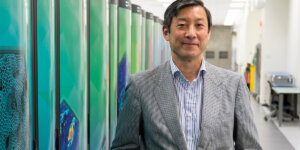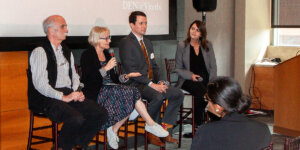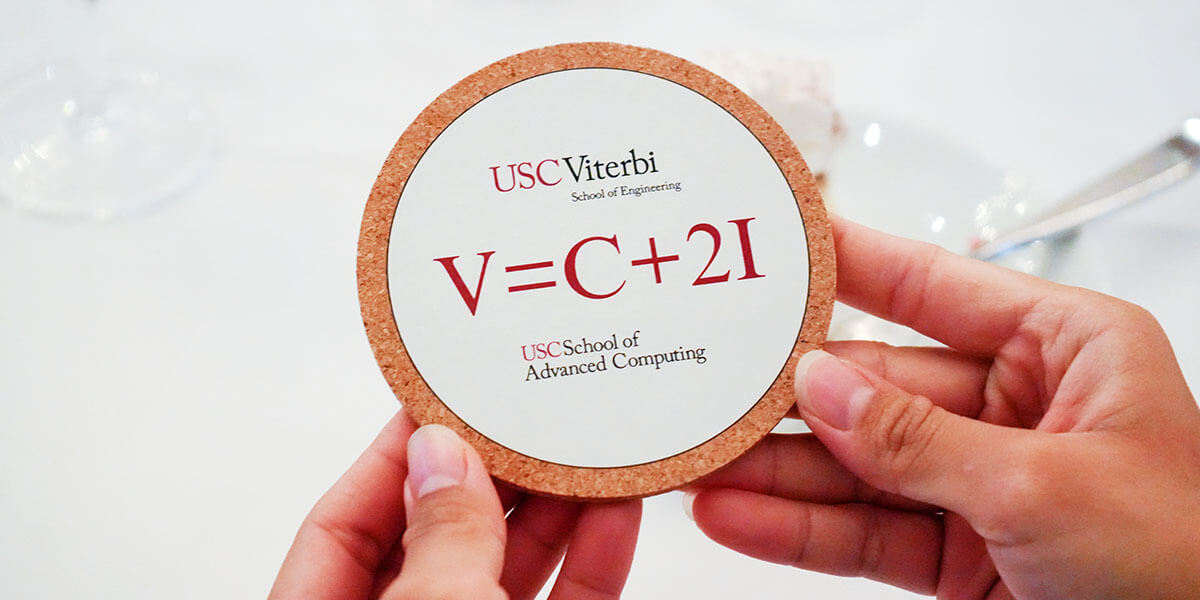
In his Sept. 19 address at Town & Gown, Yortsos introduced an equation that he had devised to capture USC Viterbi’s breadth and depth: V=C+2I. In this formulation, “V” stands for Viterbi; “C” for campus; and “2I” for the engineering school’s two research powerhouses, the USC Information Sciences Institute (ISI) in Marina del Rey and USC Institute for Creative Technologies (ICT) in Playa Vista. (Photo/Dani Orlando)
In his annual State of the School address, Dean Yannis C. Yortsos discussed the USC Viterbi School of Engineering’s major accomplishments, milestones and big wins over the past year. The dean also talked about the school’s mission, which he said is “to advance engineering education, research and innovation” and “to engineer a better world for all humanity, a goal that is shaped and influenced every day by the speed with which technology itself evolves.”
In his Sept. 19 address at USC’s Town & Gown, Yortsos introduced an equation that he had devised to capture USC Viterbi’s breadth and depth: V=C+2I.
In this formulation, “V” stands for Viterbi; “C” for campus; and 2I for the engineering school’s two research powerhouses, the USC Information Sciences Institute (ISI) in Marina del Rey and USC Institute for Creative Technologies (ICT) in Playa Vista.
“Two years ago, we celebrated the 50th anniversary of ISI. Earlier this year, the 25th of ICT. The Viterbi School is a solid amalgamation of three entities: the UPC Campus, which is 119 YEARS old, ISI and ICT,” Yortsos said. “The world is changing very fast, and a lot of this is technologically driven. And we are at the forefront of it.”
Dean Yortsos also noted that the worlds of research, discovery and innovation are increasingly multidisciplinary, interdisciplinary and transdisciplinary, which he generically referred to as “hyphenated-disciplinary.” Engineering and technology, Yortsos said, lie at the core of these intersections.
“The result is increasingly converging approaches,” he said. “Convergence is all around us. And it is not only because it helps solve problems worth our attention. It is also because it becomes an essential part, a raison d’etre, to many of our own subdisciplines.”
In his address, Yortsos also celebrated several important milestones and achievements:
- USC Viterbi’s first-year students come from 36 states, with Washington, Texas, Illinois and New York the most represented after California. The school’s acceptance rate was less than 8%. And for the sixth year in a row, the entering class has reached or neared gender balance, with 48% women. USC Viterbi’s transfer class is equally excellent, with an acceptance rate of less than 17%. And perhaps most impressive, women make up an incredible 60% of all transfer students.
- In another “extraordinary accomplishment,” Dean Yortsos said that he had just learned that ICT will soon receive a $181.3 million, five-year contract, adding that he would share more details soon.
- In recent months, Kelly Sanders, Dr. Teh Fu Yen Early Career Chair and associate professor in the Astani Department, was appointed as the assistant director for energy systems innovation for White House Office of Science and Technology Policy’s Industrial Innovation team. Similarly, Professor Najmedin Meshkati, an international expert in safety culture and human factors, testified before the Senate Committee on Commerce, Science and Transportation about Boeing’s safety processes.
The following are modified excerpts from Dean Yortsos’ 2024 remarks:
On the new School of Advanced Computing:
“Earlier this year, we created the new School of Advanced Computing, part of USC President Carol Folt’s initiative, or “moonshot,” on the Frontiers of Computing.
SAC is part of the USC Viterbi School of Engineering, in a school-within-a-school structure. It includes the Thomas Lord Department of Computer Science, the Ming Hsieh Department of Electrical and Computer Engineering, and a new division of computing education, which incorporates the Information Technology Program (ITP) and a new program in interdisciplinary data sciences.
What is unique are the newly conceived, USC- and Viterbi-wide academic entities, namely groups of “affinity faculty.” These entities will leverage strengths in advanced computing-related interdisciplinary activities across the entire university. For example, in physical sciences, in sustainability, in health, in social sciences or in the arts. A significant number of its members will have a primary academic home outside SAC, in other Viterbi departments, or across the entire university. This novel concept transcends boundaries, encapsulates as tightly as possible hyphenated disciplines, and empowers them all.”
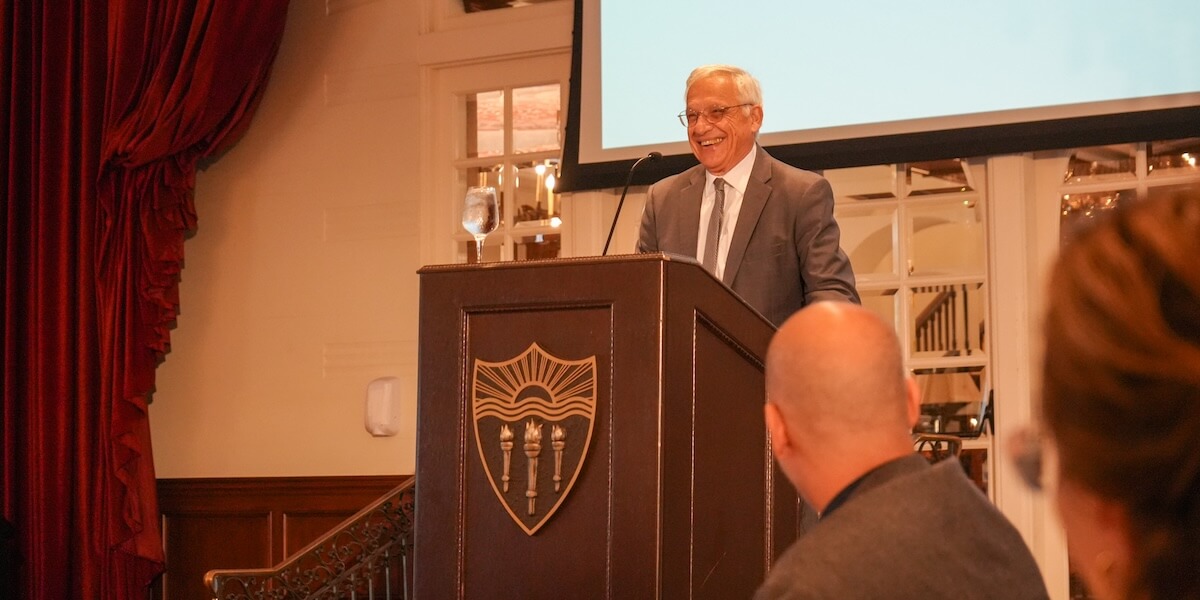
Dean Yannis C. Yortsos delivering his 2024 State of the School Address at Town & Gown (Photo/Dani Orlando)
On the Dr. Allen and Charlotte Ginsburg Human-Centered Computation Hall:
“Two days ago, we held a joyous celebration, the ribbon cutting for this new exciting building. After more than four years of planning, design, and construction, this wonderful day finally arrived. It was well worth the wait.
This flagship building will serve as the home of the Thomas Lord Department of Computer Science. But inside the walls of USC’S first LEED-Platinum Certified building on campus, many hyphenated-disciplinary teams will work together to empower all disciplines. This world-class facility is located at the nexus of a three-way convergence: the Michelson Hall for Convergent Biosciences, the Irani Hall for Molecular Biology and the Dr. Allen and Charlotte Ginsburg Human-Centered Computation Hall. Having completed such a trifecta positions USC as a world leader in research and education in engineering and computing, biotechnology and medicine.”
On the 20th anniversary of the USC Viterbi naming gift:
“We are celebrating the 20th anniversary of the school’s naming gift by Andrew and his late wife, Erna Viterbi. It was 20 years ago on March 2, 2004, when, in a brilliant celebration, in what is today the Epstein Family Plaza, the school was officially named the Viterbi School of Engineering. It’s a wonderful name to have.
Twenty years later, we have graduated more than 14,000 alumni with an undergraduate degree, more than 20,000 alumni with a graduate M.S. degree, and more than 3,000 alumni with a Ph.D. degree. They proudly carry the Viterbi name with them wherever they are in life or location in the world. And two of them are my own children, Kate and Stevie.
We celebrated the 10th anniversary of the school’s naming in 2014. Since then, we lost Erna, Steve Sample — who, as USC president, presided over the original naming ceremony — and Sol Golomb, the extraordinary genius of our faculty who closely worked with Andrew while he was completing his Ph.D. at USC.
In the span of these 20 short years since its naming, USC Viterbi faculty have won four national medals in science and technology awarded by the U.S. president, an unprecedented feat in the school’s history; 28 of our faculty have been inducted into the National Academy of Engineering; and 80 have won NSF Career Awards early career recognitions.”
On sustainability, health, security, and enriching life:
“What are the key issues of our times that should be part of our attention? As I have mentioned before, we can find them in four distinct buckets of endeavor:
Sustainability, health, security and enriching life.
These are the buckets from which the NAE Grand Challenges originated. The late visionary NAE President Chuck Vest used to call the last bucket of enriching life, ‘the joy of life,’ following which he would make the whimsical remark: ‘Engineers working on the joy of life?!’ And yes, I think that’s the truth.
Now, why these four? Because they can be mapped to the thematic components of Maslow’s hierarchy of needs of an individual, now applicable to society and the planet at large. I should hasten to add that scientific and technological discovery is also, and naturally, captured in this classification in the life enriching bucket.
Such a mindset includes the 2008 NAE Grand Challenges; it includes the UN Sustainable Development Goals; and I would venture to say that it captures practically all important academic disciplines today, as it also encompasses society-oriented, life-enriching solutions. Aspirational goals – grand challenges – have been also articulated in diverse fields of science and medicine. But they all will benefit from engineering and advanced computing, which are empowering the solution of all important endeavors and challenges. Engineering is fundamental to everything we do.”
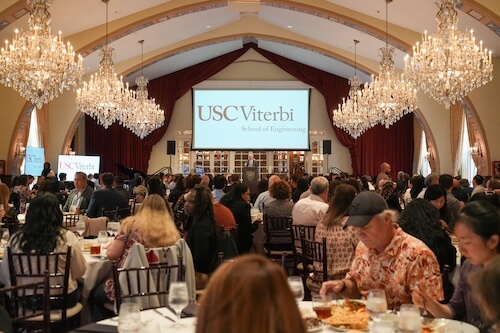
Audience members at the 2024 State of the School (Photo/Dani Orlando)
On sustainability:
“This past summer, I was given the opportunity to organize or participate in panels on this subject, one of which took place in Greece.
Now, it is fascinating to look at how the term sustainability is expressed in Greek and in English. Consider: If one asks Google to translate sustainability into Greek, the answer you will get is βιωσιμοτητα (“viosimótita”), which means viability. However, the majority of my Greek science and engineering colleagues use a different term for sustainability, namely αειφορια (“uh-e-foria”). Interestingly, this translates into thriving and prosperity, with the prefix αει indicating forever. And in a fascinating lack of forward-backward equivalence, the English translation of this Greek word (αειφορια) is sustainability, the Greek translation of which is the different word βιωσιμοτητα! What gives?
We have an opportunity to make a change. I suggest that we should break this asymmetry by endowing what in English we call sustainability, and which to some evokes a sense of maintaining, restraints, or even worse, scarcity and stagnation, with the different and forward-looking attributes of thriving and prosperity, all within the context of a healthy planet, as is inherent in αειφορια. I will leave it to the linguists to tell us how this can be accomplished!”
On the CA Dreams initiative:
“Just a few days ago, the Department of Defense (DoD) announced that it is directing $31.9 million in funding to the California Defense Ready Electronics and Microdevices Superhub (CA DREAMS). The award aims to accelerate the development of advanced semiconductor technologies through two distinct projects. Northrop Grumman, a leading global and aerospace defense technology company, will drive both projects’ execution with the University of Southern California’s leadership of the CA DREAMS initiative.
Led by USC Viterbi’s Information Sciences Institute (ISI), CA DREAMS is one of eight regional innovation hubs established under the DoD Microelectronics (ME) Commons Program. It is funded by the CHIPS and Science Act of 2022 to develop onshore microelectronics hardware prototyping, lab-to-fab transition of semiconductor technologies and extended semiconductor workforce training. The hub comprises 16 founding partners in higher education and the semiconductor industry. USC’s MOSIS 2.0 service, established as part of CA DREAMS, is accelerating prototyping in labs and fabs and streamlining the transition of processes from lab to fab.”
On the reorganization of the Ming Hsieh Department of Electrical and Computer Engineering into a single unit:
“This long overdue reorganization, after almost 50 years of separate administrative structures, which have increasingly become outdated, has led to ECE’s administrative consolidation under one structure and one chair, Richard Leahy. This move streamlines day-to-day operations as the department looks to the future as a key component of the School of Advanced Computing and continues to push the boundaries of computing and hardware design.”
On the Grand Challenges Scholars Program:
“Fifteen years ago, in 2009, we created the Grand Challenges Scholars Program for engineering undergraduates with Duke University and Olin College. As I reflect now, the program fundamentally reflects the combination of two powerful attributes of the Andy and Erna Viterbi: outstanding technical competence and outstanding character.
Spread to more than 100 universities worldwide, the GCSP received the 2022 Gordon Prize of the NAE in a wonderful celebration in the Epstein Family Plaza. It was the first time USC Engineering had won such a national honor. And in an unprecedented second feat, USC Viterbi won the Gordon Prize the following year as well, in 2023, in recognition of Professor Azad Madni’s systems engineering innovation. This tremendous accomplishment of winning the Gordon Prize two consecutive years in a row has never been reached before by any engineering school, not Stanford, not Caltech, not MIT, in the history of the Gordon Prize.”
On the Engineering in Society Program:
“With technology and humanity intertwined as never before, it is essential that we endow our students and our endeavors with a strong human-centric lens; this will help us create trustworthy engineers, namely students equipped with not only outstanding technical competence but also with outstanding character. This will help us establish trust, sorely missing in today’s world.
That’s why we created the Engineering in Society (EiS) Program. It focuses on the impact of engineering in society. It advances technology ethics – in a world where new technologies, from AI to CRISPR in genetics, open new worlds of discovery and impact, but raise equally important ethical questions and challenges. For instance, the world of ‘Nexus’ of Yuval Noah Harari, in his new book on information networks.
EiS offers new ethics courses, including: one that examines ethical issues in artificial intelligence; another that considers the ethical and social impact of technological innovations; a third that explores digital misinformation. It is also designing a Technology, Ethics and Society minor, and it is expanding efforts to embed ethics throughout the curriculum. Finally, an ethics lab is in its developmental phase.”
Published on September 24th, 2024
Last updated on September 24th, 2024




